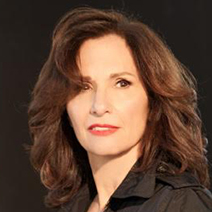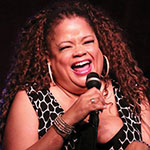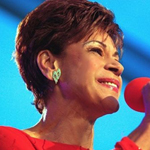Lauren White
Out of the Past
Catalina Bar & Grill, Hollywood, CA, May 15, 2016
Reviewed by Mary Bogue for Cabaret Scenes
 By definition “film noir” means “black film” or “film of the night,” reminiscent of dark alleys, bartenders who know too much, and gal singers with plunging necklines, red lipstick and high heels, men in fedoras, and grit, lots of grit coupled with betrayal, taxis and long distance phone calls placed through an operator.
By definition “film noir” means “black film” or “film of the night,” reminiscent of dark alleys, bartenders who know too much, and gal singers with plunging necklines, red lipstick and high heels, men in fedoras, and grit, lots of grit coupled with betrayal, taxis and long distance phone calls placed through an operator.
Lauren White’s Out of the Past, a tribute to this genre and the title of her new CD, was brilliantly directed and produced by Mark Winkler, who, with Joe Pasquale, wrote the anchor song, “When All the Lights in the Sign Worked,” and delivered vivid imagery against two movie screens with an assortment of classic film noir clips. White’s voice was in good placement against stunning arrangements by Kathryn Bostic and kept the audience enchanted. “You Kill Me” (Jule Styne/Leo Robin) was up-tempo jazz all the way and White kept it swinging.
Perfectly fitting the night’s theme, White seemed the most connected with the medley’s lyrics of “Laura” (David Raksin/Johnny Mercer) and “The Night We Called it a Day” (Matt Dennis/Tom Adair) as Andrew Carney seduced the full-house audience with his muted trumpet.
The crowd enthusiastically applauded a clip from Gilda, followed by White’s new version of “Angel Eyes.” Much different than her previous recording, this was uncommonly fast with long instrumentals, and the band seemed to be driving her. Finding her stride in “Amado Mio” (Doris Fisher/Allan Roberts), she became alive, more confident and in command.
She only had to ring once in “He’s Funny That Way” (Richard Whiting/Charles Daniels), getting her flirt on. This might have been her best performance of the night and best served up as the quintessential number to conclude.
Catalina’s might have been too big a venue for such an intimate show and, if repeated, warmer lighting with a spot would be more true to the subject, and a mic with more bottom to it. Perhaps White will indulge us with some of that grit and sass expected from a film noir performance and, in return, we’d whistle. We know how to whistle: we put our two lips together and … blow.





